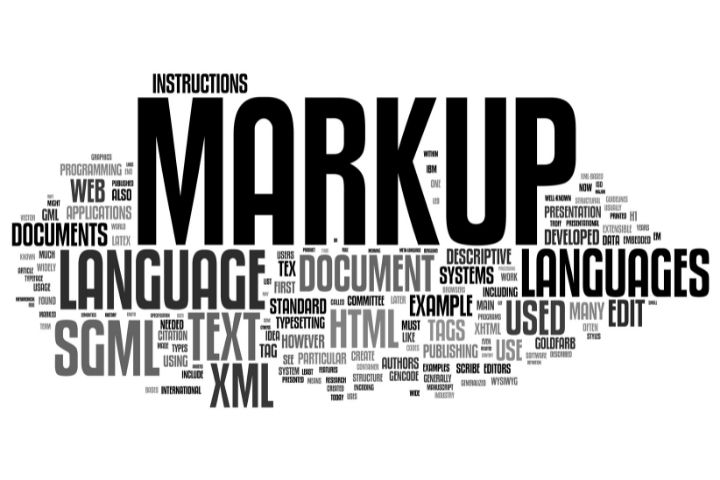What are Markup Languages?

Maybe you have seen the following abbreviations HTML, XML, XHTML, and wondered what they are. So we invite you to stay with us. Today, we will discuss what markup languages are, their main characteristics, and the most prominent markup languages.
What are markup languages?
A markup or markup language is nothing more than a way of coding or writing a document that, together with the text, adds labels – marks or annotations – with information added relative to the structure of the text or the format presentation. These languages give the possibility of making clear the structure of a certain document and its semantic content. When you look at the acronyms on the web that contains an ML, it is nothing more than a markup language.
Here is an example of the markup language, in which you can see how the text is enclosed between labels – marks or annotations – to provide it with a meaning or a certain representation :
<house>
<owner> Juan Carlos Morales </ owner>
<construction_date> 2020/04/01 </construction_date>
<direction> Morales Street between Parra and Rodríguez </direction>
</house>
A brief history of the emergence of markup languages
The nuclear physicist Tim Berners-Lee in 1989 was working on a system that could access files online over the TCP / IP communications protocol. At that time, there were two ways to link electronic documents to each other, which we mention below:
- Links or hyperlinks.
- A language called SGML ( Standard Generalized Markup Language ) was nothing more than a system for organizing and labelling documents.
The latter was standardized by the ISO in 1986 and had the purpose of specifying the labelling rules and did not impose any set of labels; knowing these methods, Tim Berners-Lee in the early 1990s created the HTML language ( Hypertext Markup Language, “Language of hypertext brands ”) as a subset of SGML and developed the World Wide Web; Also called as the web, which is nothing more than a set of hypertext documents and/or hypermedia linked together and accessible from the Internet.
And by 1991, he developed the first HTML browser that worked in text mode and for the UNIX system.
What are the main characteristics of markup languages?
What are the main characteristics of markup languages?
Next, we will mention the main characteristics of markup languages :
- Use of plain text: when used as plain text, anyone is able to read and edit that information. Characters can be written in different encodings (UTF-8, ASCII, among others).
- It is a compact language: the brand labels are joined with the content of the same.
- It is device independent: being device-independent allows content to be taught.
- Ease of processing: supports the creation of specialized languages depending on the type of document that needs to be processed.
- Flexibility: This allows us to combine with other languages.
What are the most prominent markup languages?
What are the most prominent markup languages?
Today there are multiple markup languages; below, we will show you the most prominent ones to explain them.
SGML (Standard Generalized Markup Language)
The GML format had a certain evolution until, in 1986, the ISO 8879 standard came out, which was called SGML. This was a very difficult language and required expensive software tools. As a consequence, it is not currently being used today.
Hypertext Markup Language (HTML)
HTML or HyperText Markup Language is the language of the web, and almost all web pages are written in HTML
In 1990 the nuclear physicist Tim Berners-Lee developed the World Wide Web and had the mere need to organize, link and reconcile certain information that came from multiple systems. To solve this situation, he developed a document description language with the name HTML, which was nothing more than the union of two existing standards:
- ASCII: it is a character encoding that any word processor can recognize and store.
- SGML: a language that allows giving structure to the text.
HTML is a simplification of SGML because it uses the necessary instructions. It was so easy to understand and understand that it was accepted quickly, which SMGL could not, thus becoming a general standard for developing websites and web pages. And furthermore, software tools like browsers that can view HTML pages are getting better every moment.
This language has multiple advantages, but it is not a perfect language, and below we will mention the main disadvantages are :
- It is a static language.
- Each browser can have a different interpretation.
- The labels are too limited.
- The layout is too slow.
Extensible Markup Language (XML)
Extensible Markup Language (XML)
To solve the disadvantages provided in the previous section on HTML, the World Wide Web Consortium (W3C) established in 1998 the international standard XML. This structural markup language does not contain any information related to design. It has become a standard to exchange data on the web. The difference it has from HTML is that the tags provide the meaning of the data rather than the format in which the data is to be displayed.
XML is a metalanguage characterized by :
- Allow defining your own labels.
- Allow assigning attributes to tags.
- Use a schema to define labels and attributes precisely.
- The structure and design are independent.
Extended Hypertext Markup Language (XHTML)
Extended Hypertext Markup Language (XHTML)
XHTML was born in 2000 to see the HTML language as a valid XML language and convert it from a procedural markup language to a descriptive markup language. Although it is little used in website programming, you can see how the HTML5 version and the following generations have been made in this way, focusing on the description of the content and not on its presentation.
Also Read : Best Laptops For Video Editing 2021


